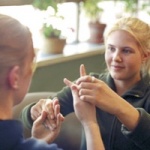
Why Physical Activity is Important to People with Deafblindness
Being physically active and exercising is beneficial for individuals of all abilities in a variety of ways including socially, physically, physiologically, and psychologically. Ensuring everyone, including those who are deafblind, have opportunities to engage in physical activity is essential to their development as an athlete and as a person.
Creating a barrier free environment to enable those who are deafblind to be exposed to the benefits of physical activity is a difficult task, but it is attainable. It requires creativity, patience and an understanding of the limits that a person who is deafblind can participate within.
Again, the most important consideration is the individuals preferred methods of communication and instruction, as these will vary for everyone regardless of their physical abilities. Please consider the following information as general guidelines for working with someone who is deafblind.
Teaching and Communication Techniques for Physical Activity Leaders
- Ensure there is an interpreter or an intervenor present working directly with the participant.
- Learning needs to take place through doing. Work within the comfort level of the individual and encourage participation in new activities.
- People who are deafblind may use symbols, objects of reference, sign language, Braille, or other communication systems to communicate. Discover the preferences of the individual and work within these preferences. Work through the interpreter or intervenor if you are not comfortable with these modes of communication.
- Do not set a pre-established pace for lessons. It is important to move forward at the participants own pace. The exploration of new movements takes time and will vary depending on each individual.
- Do not be overprotective. Provide a safe environment but allow the participant to explore and participate further if they choose to do so.
- For the individual, there may be little awareness of events before they actually occur. Make interactions balanced (my turn, your turn) to encourage appropriate responsiveness.
Modifying Leisure, Sport and Recreation Activities
- Continually focus on core fundamental movement skills in promoting physical literacy. As a majority of sensory information is learned through sight and sound, it is important to repeat basic movements multiple times to ensure mastery. Skills such as walking, running, climbing, skipping, bouncing and throwing should be encouraged.
- Create physical activity opportunities in a variety of environments and terrains including walking over rocks and logs, through fields and puddles, crawling or ducking under branches, and hanging from low branches. Introduce the participant to their outside surroundings and teach them different movements associated with these surroundings.
- The participant may first need to be led physically through an activity to know what is expected of them. After they understand what is expected, this support should be reduced to avoid building dependence.
- Safety is the number one priority for any sort of physical activity. Not only must the environment be made safe for a participant, they must also feel safe in order to move around confidently.
More About Deafblindness
What is Deafblindness?
A person who is deafblind has a substantial degree of loss in sight and hearing, the combination of which results in significant difficulties in accessing information. Deafblindness is a complex disability that combines varying degrees of both hearing and visual impairment, making it unique to each individual. A person can either be born with deafblindness (congenital) or can acquire deafblindness later in life (acquired).
Impact of Deafblindness
- Individuals who are born deafblind (congenital) may often have additional disabilities.
- There are extreme difficulties in communicating, learning, understanding language and reading. This greatly affects the development of movement and motor skills.
- Intellectual and cognitive development may often be very slow.
- Individuals may have difficulty controlling behavior and expressing emotions.
- There may be a sizable deficiency in social skills.
- Daily living activities are extremely difficult.
- There may likely be a large difference in barriers to development depending on whether or not deafblindness is congenital or acquired later in life. If the participant has an acquired disability, it is probable that they will have a stronger sense of fine motor skills.
Useful Information About Deafblindness
- 95% of what a person learns comes from their vision and hearing. As such, a person who is deafblind faces significant challenges and barriers to full participation in society.
- It is estimated that deafblindness occurs in 1 in every 3,000 Canadians. Approximately 211,250 Ontarians are deafblind.
Resources
Canadian Deafblind Association (National) - www.cdbanational.com/
Adapting Games, Sports and Recreation for Children and Adults who are Deaf-Blind - https://digitalcommons.brockport.edu/cgi/viewcontent.cgi?article=1110&context=pes_facpub
About Deaf-Blindness - www.deafblind.ufl.edu/welcome/about-deaf-blindness/
Teaching Strategies and Content Modifications for the Child with Deaf-Blindness - www.tsbvi.edu/seehear/archive/strategies.html
Helping Canadians with Disability/Chronic Disease Get Physically Active
For Canadians with a disability, regular physical activity may be even more important than it is for the rest of the population. For a person with a disability, an active lifestyle can open doors to increased health, social inclusion and self-empowerment - doors which might otherwise remain closed. Access to physical activity can eliminate the likelihood of acquiring secondary health conditions like diabetes, high blood pressure or heart disease. Being active builds resiliency and can provide an all-important outlet for a person with a disability.
This project would not have been possible without the expertise of our partners. ALACD would like to sincerely thank these organizations for working with us to develop this resource: the Ontario Blind Sports Association, Variety Village, the National Network for Mental Health, and the Learning Disabilities Association of Canada.




